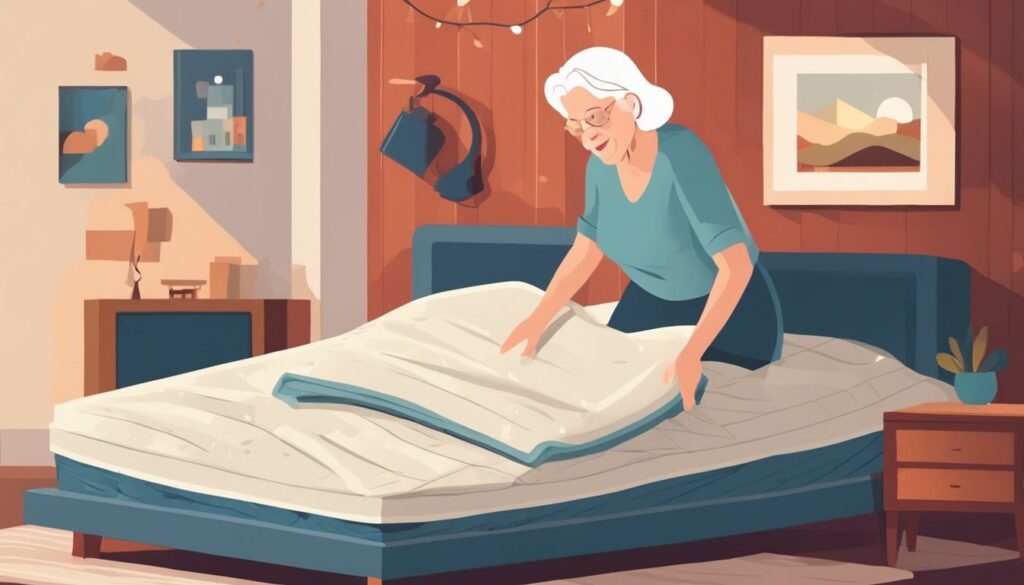Are you a senior struggling with poor sleep quality? Many older adults don’t realize their mattress could be the culprit. On average, a mattress lasts between 7 to 10 years before needing replacement.
This blog will guide you through when and why seniors should consider getting a new mattress. Your comfort and health are at stake – don’t miss out on better sleep.
📋✅
- Seniors should replace their mattresses every 7-10 years to ensure optimal comfort and support for aging bodies.
- Signs it’s time for a new mattress include waking up sore, visible wear like sagging or lumps, and worsening allergy symptoms.
- Factors to consider when choosing a new mattress for seniors include comfort level, firmness, edge support, temperature regulation, and motion isolation.
- A medium-firm mattress typically offers the best balance of support and pressure relief for older adults.
- Regular mattress replacement can improve sleep quality, reduce aches and pains, and decrease exposure to allergens like dust mites and mold.
Understanding Mattress Lifespan for Seniors

Mattress lifespan for seniors depends on several factors. Quality, usage, and care all play a role in how long a bed will last.
Key Factors That Influence Lifespan
Several key elements affect how long a mattress lasts for seniors. Quality plays a crucial role – higher-end products often use better materials and construction techniques, leading to increased durability.
The type of mattress also matters; memory foam, latex, and hybrid options tend to outlast traditional innerspring models. Weight and activity levels impact lifespan too. Heavier individuals or those who spend more time in bed may need to replace their mattresses sooner.
Proper care extends a mattress’s life significantly. Using a protective cover shields against spills, sweat, and dust mites. Regular rotation helps distribute wear evenly. Adequate support from a solid foundation prevents sagging.
Avoiding excessive weight or jumping preserves internal structures. Frequent cleaning and airing out combat allergens and odors.
A good bed is a blessing that demands to be counted every night. – Unknown
Signs It’s Time to Replace the Mattress
Is your mattress causing you discomfort? Watch out for these telltale signs that it’s time for a new one. Your body will thank you for the upgrade, and you’ll wake up feeling refreshed and ready to tackle each day.
Waking Up Sore
Seniors often experience morning soreness due to an aging mattress. This discomfort signals inadequate support, affecting sleep quality and overall well-being. A worn-out sleep surface fails to properly align the spine, leading to muscle tension and joint pain upon waking.
Persistent aches – especially in the lower back, hips, or shoulders – indicate it’s time for a mattress upgrade.
Replacing an old mattress can significantly improve sleep comfort for older adults. A new, supportive surface helps reduce pressure points and promotes better spinal alignment. This leads to less tossing and turning, deeper sleep cycles, and decreased morning stiffness.
For seniors dealing with arthritis or other joint issues, a proper mattress becomes even more crucial in managing pain and maintaining mobility.
Visible Signs of Wear
Moving from waking up sore to visible signs of wear, it’s crucial to inspect your mattress regularly. Physical damage often indicates the need for replacement.
Sagging spots, lumps, or exposed springs are telltale signs of a worn-out mattress. These issues can lead to poor sleep quality and potential back problems. A mattress protector can help prevent some wear, but it won’t stop all damage.
Foam and latex mattresses may show body impressions over time, while innerspring mattresses might have noticeable coils. Regular checks can help catch these issues early.
A good mattress is a foundation for healthy sleep.
Allergies or Asthma Worsening
Older mattresses can harbor allergens like dust mites, mold, and bacteria. These microscopic invaders multiply over time, potentially triggering allergic reactions or worsening asthma symptoms in seniors.
A sudden increase in sneezing, coughing, or breathing difficulties – especially upon waking – may signal it’s time for a new sleep surface.
Regular mattress replacement helps reduce exposure to these irritants. For seniors with respiratory sensitivities, experts recommend choosing hypoallergenic materials like latex or certain types of memory foam.
These options resist allergen buildup better than traditional innerspring mattresses, promoting cleaner air and easier breathing throughout the night.
Benefits of Napping for Seniors
Napping offers significant advantages for older adults. A brief rest during the day can enhance mood and cognitive function, leading to improved overall well-being. Research shows that a 20-30 minute nap can boost alertness, memory, and problem-solving skills in seniors.
This short period of sleep also helps reduce stress and fatigue, allowing older individuals to feel more energized for the remainder of their day.
For seniors struggling with nighttime sleep issues, daytime naps can provide much-needed rest without disrupting their regular sleep patterns. However, it’s crucial to time naps correctly – ideally in the early afternoon – to avoid interfering with nighttime sleep.
A comfortable foam mattress or supportive pillows can make napping more restful, ensuring seniors wake up refreshed and ready to tackle their daily activities.
Recommended Replacement Frequency
Seniors should replace their mattresses every 7-10 years. This timeframe ensures optimal comfort and support for aging bodies.
General Guidelines for Seniors
Experts suggest seniors replace their mattresses every 6 to 8 years. This timeframe ensures optimal comfort and support for aging bodies. Quality materials and proper care can extend a mattress’s life, but regular replacement is crucial for health and sleep quality.
Caregivers should help seniors assess their mattress condition regularly. Look for signs of wear like sagging, lumps, or exposed springs. If the senior wakes up with aches or experiences worsening allergy symptoms, it might be time for a new sleep surface.
The next section will guide you through choosing the right mattress for your senior loved one.
Choosing the Right Mattress for Seniors
Selecting a mattress for seniors requires careful thought. Comfort, support, and health needs should guide the choice.
Factors to Consider
Choosing the right mattress for seniors requires careful consideration. Here are key factors to keep in mind when selecting a new sleep surface:
- Comfort level: Find a mattress that provides proper support for the spine and joints. Memory foam or hybrid mattresses often work well for seniors with arthritis or back pain.
- Firmness: A medium-firm mattress typically offers the best balance of support and pressure relief for older adults. Test different options to find the ideal firmness.
- Edge support: Look for reinforced edges that make it easier to get in and out of bed safely.
- Temperature regulation: Seniors may prefer mattresses with cooling properties to prevent overheating at night. Some models use gel-infused foams or breathable materials.
- Motion isolation: For couples, choose a mattress that minimizes motion transfer to reduce sleep disruptions.
- Height: Select an appropriate mattress height that allows easy access without straining.
- Durability: Invest in a quality mattress made with long-lasting materials to extend its lifespan.
- Allergies: Hypoallergenic mattresses can help reduce reactions to dust mites, mold, and other allergens.
- Budget: Set a realistic budget while prioritizing comfort and support. Quality mattresses are an investment in health.
- Return policy: Check the trial period and return options in case the mattress isn’t a good fit after extended use.
Regular mattress replacement is crucial for seniors’ health and comfort. A fresh bed can alleviate aches, improve sleep quality, and reduce allergy symptoms. Experts recommend changing mattresses every 7-10 years, but individual needs may vary.
Pay attention to your body’s signals and visible wear on your current mattress. Investing in a suitable new mattress tailored to your needs can significantly enhance your overall well-being and daily life.
To learn more about how proper rest can improve your well-being, read our article on the benefits of napping for seniors.
FAQs
1. How often should seniors replace their mattresses?
Seniors should replace their mattresses every 7-10 years. A sagging mattress can lead to poor sleep and health issues. Regular mattress maintenance can extend its life, but eventually, a new one is needed for good sleep.
2. What signs indicate it’s time for seniors to get a new mattress?
Key signs include a sagging mattress, increased allergies or asthma symptoms, and trouble sleeping. If you wake up with a runny nose or feel like an insomniac, it might be time for a change. Dust mites, mold, and bacteria can build up over time.
3. Are memory foam mattresses good for seniors?
Memory foam mattresses can be great for seniors. They offer good support and pressure relief. But, they’re not for everyone. Some find them too warm or hard to move on. It’s best to try different types before buying.
4. How can seniors maintain their mattresses to make them last longer?
To extend mattress life, rotate it regularly. Use a mattress protector to guard against spills and dust mites. Vacuum it often to remove allergens. For waterbeds, check for leaks and condition the water. Good care can help avoid the need for sleep aids due to discomfort.









